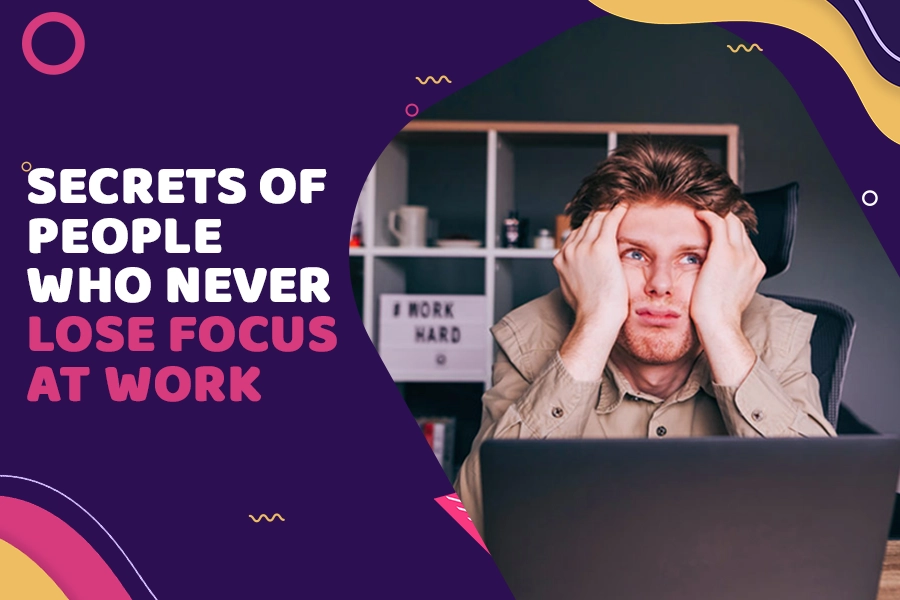We all know someone who looks calm, collected, and strangely unstoppable at work — they finish projects on time, breeze through meetings, and seem to have a supernatural ability to stay focused. The truth is, most of those people aren’t born that way. They use a set of practical habits, environment tweaks, and mental strategies that together create reliable focus. This post pulls those secrets into a single, usable guide so you can borrow the best parts and make them your own.
The mindset first: focus is a skill, not a trait
People who never lose focus treat attention like a muscle. They don’t assume focus is something you either have or don’t — they practice it. That mindset shift changes everything: instead of blaming yourself for distractions, you start analyzing when and why you drift and implement strategies to fix it.
Key idea: short-term lapses are normal; consistent systems win. Focus masters create systems that reduce the number of choices, friction, and triggers that lead to distraction. Over time, those small systems compound into major gains in productivity and mental sharpness.
Habit architecture: the backbone of sustained focus
High-focus people build routines that guide energy and attention predictably.
- Morning focus ritual. They have a short morning ritual (15–45 minutes) that primes concentration: hydration, quick movement, a written priority list for the day (3 top outcomes), and a single deep-block scheduled for the morning’s best hours. This isn’t ritual for the sake of ritual — it intentionally aligns willpower and energy to the hardest task.
- Single-tasking is the default. Multitasking reduces efficiency and increases cognitive fatigue. Focus-strong people single-task: one document, one meeting, one goal. They use explicit markers (“I will write section A for 50 minutes”) and honor that boundary.
- Time blocking. They schedule the day into blocks: deep work, shallow tasks, breaks, and meetings. Time blocks aren’t rigid jail cells; they’re commitment devices that keep focus transitions deliberate.
- End-of-day review. A five-minute wrap-up where they note progress, capture unfinished items, and set the top three priorities for tomorrow. This reduces tomorrow’s cognitive load and helps sleep.

These habits are simple, but the consistency makes them powerful. Build one at a time — don’t try to overhaul everything in a week.
Environment design: make distractions hard and focus easy
The most underrated secret: tweak your environment to favor attention.
- Clutter-free workspace. Visual clutter taxes working memory. Keep only the items you need for the current task on the desk.
- Single-purpose zones. If possible, have different spots for deep work and shallow work (or at least different setups). Your brain learns associations: a “deep work” place triggers concentration rituals.
- Device hygiene. Turn off nonessential notifications. Use “Do Not Disturb” modes during deep blocks. Silence, not deletion — you can always re-enable them later.
- Micro-commitments to focus. A visible timer, a “do not disturb” sign, or even noise-cancelling headphones are small signals that reduce interruptions. They’re not for show — they reduce the number of times others break your flow.
- Optimal lighting and ergonomics. Comfortable posture and good light keep fatigue at bay, making you more likely to sustain mental sharpness.
Environment design is not about perfection — it’s about reducing the friction that interrupts focus.
Techniques that actually work
Here are battle-tested techniques people who stay focused use every day.
- Pomodoro with intention. Work 25–50 minutes, break 5–10 minutes. But don’t just time it — decide on a specific, measurable mini-goal each session (e.g., “edit 600 words,” “complete slide 3”).
- Two-minute rule for micro-tasks. If a task takes less than two minutes, do it immediately; otherwise, time-block it. This prevents small tasks from accumulating and breaking focus.
- Timeboxing for email. Instead of letting email be an ever-present task, reserve two fixed slots for it (e.g., 10:00–10:30 and 16:00–16:30). Outside those slots, treat email as closed.
- Batching similar tasks. Group similar tasks (calls, admin, creative work) and do them in sequence to reduce context-switching costs.
- Pre-mortem for meetings. Before every meeting, write one sentence: “If this meeting fails, it will be because…” That prompt keeps meetings short, outcome-focused, and less draining.
- Single-minute priorities. At the start of a focus block, write a one-sentence aim. This aligns attention and helps evaluate success at the end.
Energy management: sleep, food, movement, and mental sharpness
You can’t sustain focus on depleted energy. High-focus people manage energy first, tactics second.
- Sleep is non-negotiable. Most cognitive problems come from sleep debt. Prioritize consistent bedtimes and wake times whenever possible.
- Movement breaks that restore focus. Short walks, stretching, or even desk mobility resets attention and reduces decision fatigue.
- Fuel for focus. Balanced meals, stable blood sugar, and hydration improve concentration. Avoid heavy, carb-only meals right before deep work.
- Micro-napping strategy. When possible, a 10–20 minute power nap can restore alertness significantly. Many top performers use these strategically.
- Mindfulness and breathing. Quick breathing exercises (4–4–4 box breathing, or 60 seconds of diaphragmatic breathing) calm racing thoughts and sharpen focus before a big task.
Think of your body as the hardware that runs your attention software. Keep it updated.
Digital strategy: tame the internet monster
Most attention loss these days comes from connected devices. People who stay focused adopt a digital policy.
- Batch social and non-work browsing. Schedule short “internet windows.” Outside those windows, block distracting domains.
- Use friction, not willpower. Add small friction where you need it: uninstall an app from your phone if it’s a frequent distraction; move it to a folder; require a password to open it.
- Use tools wisely. Productivity apps can help if they’re lightweight and non-addictive. Avoid installing a dozen trackers; pick one or two tools and master them.
- Guard your morning. The first hour after waking is sacred for people who stay focused — they avoid email and social feeds to preserve mental clarity.
Digital discipline is less about restriction and more about intentionality: decide when and why you use tech.
Habits to build over months
Short-term tricks help, but lasting focus comes from slower, compounding practices.
- Learn to say no. Protect your calendar. Each “yes” is a time and attention allocation; be deliberate about it.
- Practice “deep work” blocks. Regular, distraction-free deep work sessions build the cognitive stamina to concentrate for longer. Increase length slowly (e.g., add 10 minutes per week).
- Skill-specific practice. Focus improves when your work is challenging but not impossible — that sweet spot fuels flow states. Keep tasks appropriately demanding.
- Reflective journaling. Weekly reflection on what drained focus and what boosted it creates a feedback loop to refine systems.
These changes compound. After a few months, you’ll notice you can sustain attention for much longer periods with less effort.
Social and workplace hacks
Focus doesn’t happen in a vacuum. People who remain concentrated use social strategies.
- Clear communication. Tell your team your deep-work hours. Normalizing “quiet time” reduces interruptions.
- Meeting hygiene. Only schedule meetings with clear agendas and defined outcomes. Invite only the necessary people.
- Collaborative calendars. Use shared calendars so people know when you’re available and when you’re in focus blocks.
- Accountability partners. Pair up with a colleague to protect focus windows or run “sprints” together — social commitment increases follow-through.
Culture shapes personal behavior. Push your environment toward focus-friendly norms and you’ll benefit from the change.
Quick 7-day plan to hack your focus
If you want to try it, here’s a minimal plan people use to bootstrap habits:
Day 1: Decide on your top three priorities for the week. Schedule one 90-minute deep block tomorrow morning.
Day 2: Implement one digital boundary (e.g., 2 email checks/day). Try one Pomodoro session.
Day 3: Do a 10-minute midday walk and hydrate deliberately. Track your energy.
Day 4: Create a “do not disturb” signal for your workspace. Protect one deep block.
Day 5: Batch and clear 30 minutes of small tasks in a single slot.
Day 6: Do a 20-minute reflective journaling session: what worked, what didn’t?
Day 7: Review metrics (tasks completed, energy, interruptions) and plan next week’s focus windows.
Small experiments create momentum. Adjust based on what you learn.
FAQs
Q: What if my job requires constant interruptions?
A: If you can’t avoid interruptions, carve out one short, guaranteed deep block per day and protect it. Use the rest of the day for shallow tasks and triage. Over time, increase your protected time.
Q: Is caffeine helpful or harmful for focus?
A: Caffeine can boost alertness in the short term but can harm sleep and create energy crashes. Use it strategically (morning or early afternoon), and avoid dependence as a substitute for sleep or good habits.
Q: How long should a focus session be?
A: Start with what fits your current stamina: 25–50 minutes is common. Build up toward 90–120 minute blocks if your work requires deep thinking.
Q: How do I stop doomscrolling during breaks?
A: Replace passive breaks with restorative activities (short walk, stretch, breathing). If you want a digital break, set a strict 10–15 minute timer and use a site blocker until the timer finishes.
Q: What if I get anxious when I try to focus?
A: Anxiety often comes from unclear priorities or fear of perfection. Start with a very small, specific aim for the session and allow imperfect progress. Grounding breathing for 60 seconds before starting helps, too.
Common mistakes (what to avoid)
- Over-optimizing tools. Tools are useful, but constant tool-hopping is a time sink.
- Expecting an overnight change. Focus is built slowly. Quick fixes create temporary improvements but rarely stick.
- Using focus as avoidance. Sometimes we use busyness to avoid decisions. Make sure focus aligns with meaningful outcomes.
- Ignoring well-being. If you push focus at the cost of sleep, relationships, or health, gains will backfire.
Final thoughts: focus is about design + practice
People who “never” lose focus usually mean they have fewer freak-out moments and more systems that make distraction the exception, not the rule. The secret is rarely a single hack — it’s the combination of routines, environment, energy management, and social norms that protect attention day after day.
If you take one thing away: choose one focus-friendly habit, practice it for three weeks, then add another. Small consistency beats sporadic intensity every time.
References
- Cal Newport — Deep Work: Rules for Focused Success in a Distracted World (book)
- Francesco Cirillo — The Pomodoro Technique (method and book)
- Daniel Goleman — Focus: The Hidden Driver of Excellence (book)








Leave a Reply